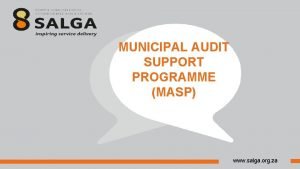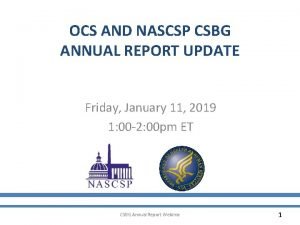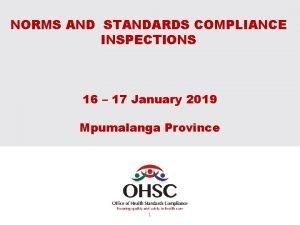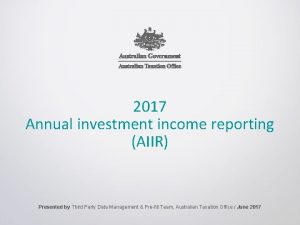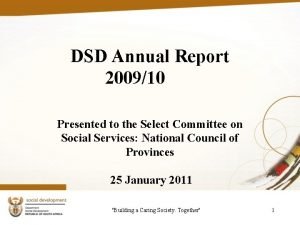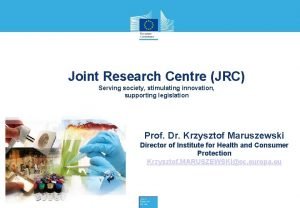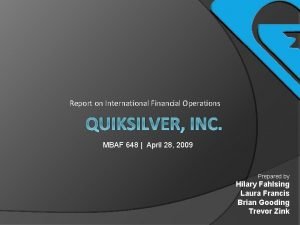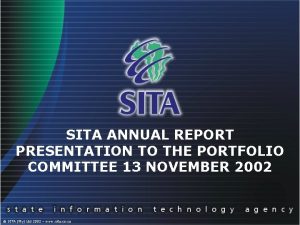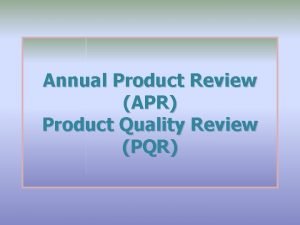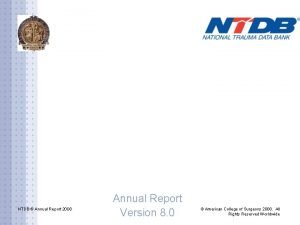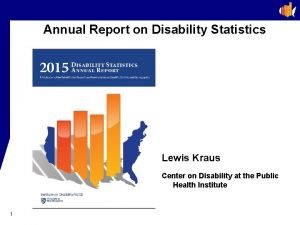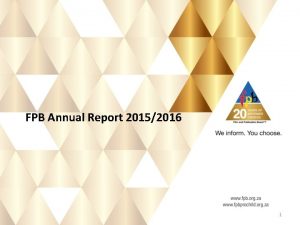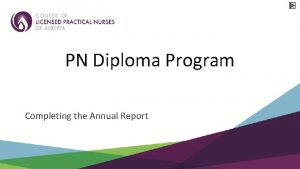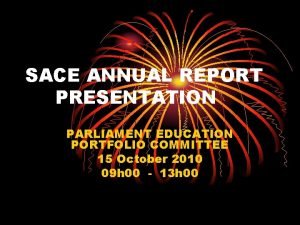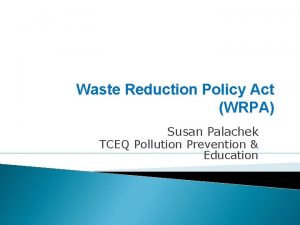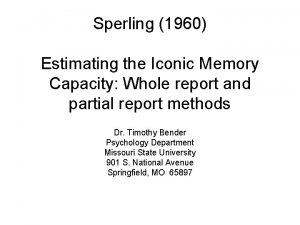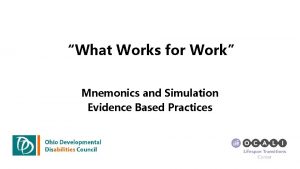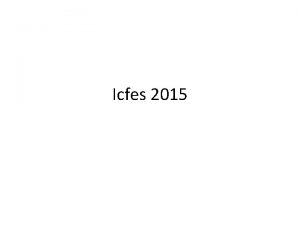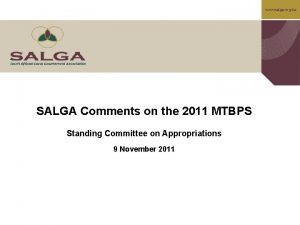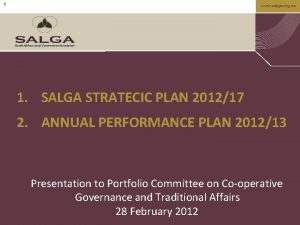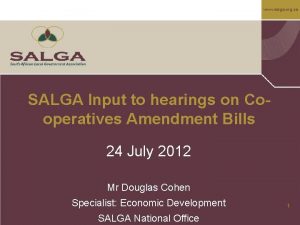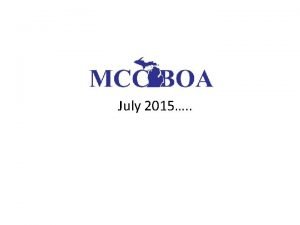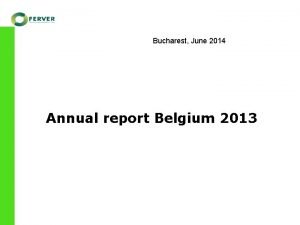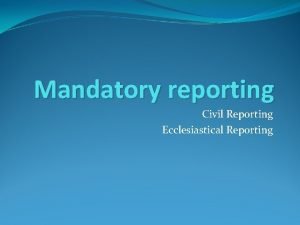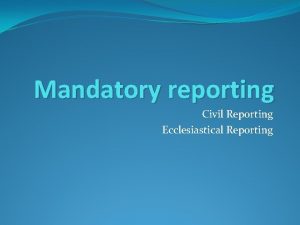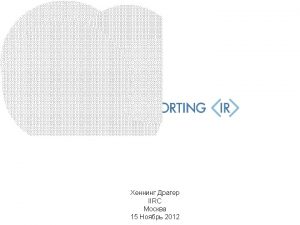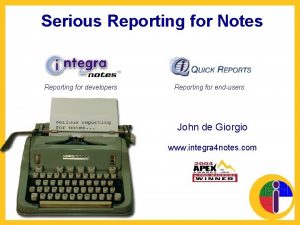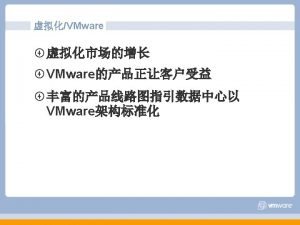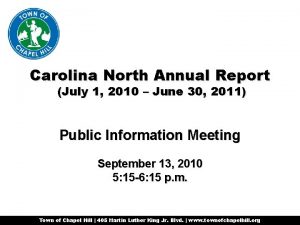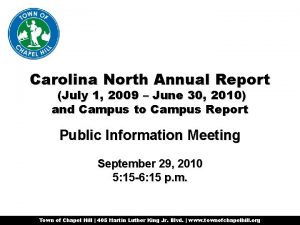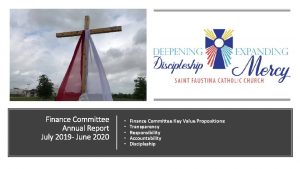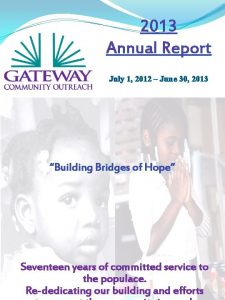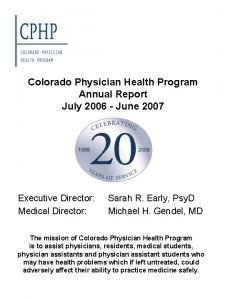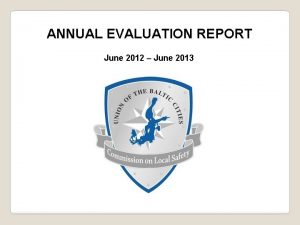SALGA ANNUAL REPORT JULY 2006 JUNE 2007 REPORTING







































































- Slides: 71

SALGA ANNUAL REPORT JULY 2006 – JUNE 2007 REPORTING PERIOD Presentation to Parliament 2008 by The Chief Executive Officer, Mr. Xolile George

STRUCTURE OF PRESENTATION This Annual Report assesses SALGA’s performance against planned targets as per its business plan for 2006/7. 1. Introduction Overview by the CEO 2. Programme Performance In addition to reporting on the milestones achieved, the second part of the presentation provides a programme-by-programme account of SALGA’s achievements over the year, elucidating some of the challenges experienced as well as looking ahead to the 2007/8 financial year. 3. Financial Overview The Annual Financial Statement for the 2006/7 financial year provides the financial information in support of programme performance.

OVERVIEW BY THE CEO • Annual Report for the financial year 2006/2007 presented in accordance with the provisions of the Public Finance Management Act No, 1 of 1999 (as amended). • Appointment of new CEO of SALGA took place in April 2007 and coincided with the urgent task of consolidating SALGA into a unitary structure: in form, scope and substance. This process will culminate into SALGA being redesigned into a fully fledged unitary entity under one administration and with fully operative political governance structures. • The Unitary structure will enable SALGA to play a leading and assertive role in being the main opinion maker and a key point of reference in matters that pertain to the municipal sector. • At the institutional level, new administrative policies and procedures aimed at enhancing efficiency and effectiveness as well as the tightening of financial controls and systems of accountability are being established.

OVERVIEW BY THE CEO (Continued) • With the set of measures and interventions being implemented to improve the corporate functioning and governance of SALGA, the organisation is set on a new path towards being a focussed and strategic entity, better shaped to serve its members and giving optimal effect to the 5 year Local Government Strategy Agenda. • In the area of advocacy and lobbying, SALGA continues to focus on strengthening its capacity through an enhanced system of meaningful and mandated participation and representation in key inter-governmental relations structures, both at the Provincial and National levels. • Since the commencement of the transformation of Local Government in 1996, the sector continues to be challenged by skills acquisition, retention and appropriate qualification. In addition to the Councillor Induction Programme, SALGA introduced capacitation programmes for both councillors and municipal officials e. g. Executive Municipal Leadership Development Programme (EMLDP) and Local Democracy and Local Government (LODLOG) over the past year.

OVERVIEW BY THE CEO (Continued) • The centrality of SALGA to the local government transformation process has made it almost inevitable that sectoral change should dictate a review of SALGA’s modus operandi in order to increase its ability to effectively support and represent its members. Hence, the last few months of the 2006/7 financial year has witnessed a radical review of SALGA’s strategy as well as its institutional arrangements. • In terms of partnerships, SALGA continues to work closely with the Department of Provincial and Local Government and enjoys the support of other national departments such as the Department of Water Affairs and Forestry. SALGA has also strengthened its relationship with the Dutch Embassy, the Commonwealth Local Government Forum, United Cities and Local Governments of Africa and the United Cities and Local Governments (the world body representing local government). • During the course of the last financial year, SALGA also created and strengthened ties with other key national departments, and national associations of local government in Africa.

OVERVIEW BY THE CEO (Continued) • Whilst SALGA has recorded a number of achievements in the last financial year there are many areas in which organizational performance will be improved. Hence some of the key priorities for the next financial year will be: - Re-designing and repositioning SALGA into an effective and visible organisation - Re-align organisational output in accordance with new strategic objectives - Building organisational capacity at both provincial and national levels - Optimising SALGA’s administrative efficiency and effectiveness including instituting systems and procedures that will improve the integration between strategy and business planning, implementing a budget framework and financial management system, establishing a Performance Management System, developing a legal compliance framework and reporting system, initiating an internal audit and risk management system, and conducting a high -level organisational review.

OVERVIEW BY THE CEO (Continued) - Improving internal skills base and external networks in order to provide better and effective on-site support to municipalities - Improving communication between SALGA and its membership as well as rolling out a comprehensive communications network and IT architecture to improve Local Government connectivity. - Significantly improving the corporate governance and financial accountability of SALGA. - Engaging and providing leadership to member municipalities on the key policy restructuring initiatives aimed at local government

OVERVIEW BY THE CEO (Continued) Five-Year Local Government Strategic Agenda • • The Five Year Local Government Strategic Agenda is the central policy thrust for local government in South Africa. SALGA has however not been able to optimally support this Agenda It therefore becomes critical for SALGA to add value to the Local Government Strategic Agenda and for its strategic plan to be influenced accordingly for its new term of office

PROGRAMME PERFORMANCE The activities of SALGA during the 2006/7 financial year were organised under the following programmes: • • • Office of the CEO Finance and Corporate Service Governance and Inter-Governmental Relations Municipal Services Municipal Labour Relations, Human Resources and Skills Development International Relations, Research and Policy Development Unit, Protocol and Support Services and, Marketing and Communications

PROGRAMME PERFORMANCE (Office of the CEO) Programme One: Office of the CEO Strategic Objectives: 1. Increase SALGA’s effectiveness and efficiency to enhance sustainability of organised local government and quality of service to its members 2. To foster policy, strategy and operational integration of SALGA 3. To foster planning, reporting and budgetary context for the organisation as a whole

PROGRAMME PERFORMANCE (P 1 - OCEO) (Continued) Key achievements for the period: • In the past financial year SALGA has been able to fully operationalise all governance structures both at provincial and national levels. • All provincial associations have their Provincial Members Assembly and the vacant positions resulting from the outcome of March 2006 elections were filled. SALGA is very active in all intergovernmental bodies such as MINMECs, PCC, and NCOP etc. • SALGA managed to increase subscriptions by municipalities during the course of the financial year. • Collection of revenue increased by 21% at the end of the financial year. • An Audit Committee was also established and the Auditor General has representatives thereon. • During the course of the year, the capacity building of member municipalities through continental and international exchanges and peer learning in key areas were facilitated and supported.

PROGRAMME PERFORMANCE (P 1 - OCEO) (Continued) Key challenges for the period: • • • Despite the achievements mentioned above, a number of issues remain outstanding. For instance, acquiring SALGA’s own office building, delisting of SALGA as a schedule 3 A entity, implementation of the performance management system, disclaimer of audit opinion for 2006/7, outstanding court cases, review of the formula for subscription levies, development of a communication strategy and the operationalisation of twining arrangements are being attended to in accordance with sound corporate governance principles. Secretariat services currently disjointed and poorly capacitated. Tracking of past executive decisions; both at National & Provincial levels not systematically archived for easy accessing and referrals. Legal compliance in decision making not checked and monitored for consistency across the organisation.

PROGRAMME PERFORMANCE (P 1 - OCEO) (Continued) Plans for 2007/8: • • • Re-designing and repositioning SALGA into an effective and visible organisation Building organisational capacity at both provincial and national levels Implementing a Budget Framework and Financial Management System, establishing a Performance Management System, developing a legal compliance framework and reporting system, initiating an internal audit and risk management system, and conducting a high-level organisational review. Improving communication between SALGA and its membership as well as rolling out a comprehensive communications network and IT architecture to improve Local Government connectivity. Engaging and providing leadership to member municipalities on the key policy restructuring initiatives aimed at local government i. e. Electricity Distribution Industry Establishment of a Single Public Service Provincialisation of Primary Health Services

PROGRAMME PERFORMANCE (P 2 – Finance & Corporate Services) (Cont. ) Programme Two: Finance and Corporate Services • • Reporting under this programme are the following sub-divisions: – Administration – ICT – HR Finance is reported in part 3 of this presentation.

PROGRAMME PERFORMANCE (P 2 – Finance & Corporate Services) (Cont. ) Strategic Objectives: • Increase SALGA’s effectiveness, efficiency to enhance sustainability of Organised Local Government through planning, budgeting, accountability and reporting, thus improving the quality of service to its members. • Effectively manage the SALGA administrative structuring and integration processes • Enhance SALGA’s capacity building initiative • Ensure the establishment of a culture of continuous improvement

PROGRAMME PERFORMANCE (P 2 – Finance & Corporate Services) (Cont. ) Key achievements for the period: • A Registry Office was set up during the year which has helped to improve document management. Administration Policies, Procedures, Systems and activities were reviewed to ensure: - Alignment with current processes and procedures; - Incorporating recommendations of the Auditor-General’s office; - Compliance with relevant legislation • As far as ICT is concerned, the directorate implemented an MPLS Virtual Private Network linking all SALGA provinces and sites. The SALGA Intranet was also extended to all the 9 provinces.

PROGRAMME PERFORMANCE (P 2 – Finance & Corporate Services) (Cont. ) • • • With respect to human resources, 81% of positions were filled as at 30 June 2007. A standard set of conditions of service for the purpose of harmonization within SALGA was also developed and standard procedures for policies at National and Provincial offices have been implemented. Training programmes for employees were conducted as part of SALGA’s employee capacity enhancement programme. Below is a summary of the number of employees recruited during the financial year, the number of contracts terminated, the number of suspensions pending disciplinary investigations, the number of automated leave applications processed, training interventions and employee wellness interventions.

PROGRAMME PERFORMANCE (P 2 – Finance & Corporate Services) (Cont. ) Number of employees recruited Number of employment contracts terminated 55 Total Contract not renewed 1 Discharged 1 Passed Away 1 Resigned Voluntary Retrenchment Number of suspensions pending disciplinary investigations Number of automated leave applications processed Number of times an employee attended a training intervention Employee Wellness Interventions 32 28 1 2 1505 699 44 7 Individual employee interventions 13 Employees assisted to further their studies 2 Main wellness interventions across the organisation 22 Electronic information dissemination campaigns

PROGRAMME PERFORMANCE (P 2 – Finance & Corporate Services) (Cont. ) Staffing of SALGA offices during July 2006 to June 2007 PROVINCE NUMBER OF POSTS FILLED POSTS VACANT POSTS EASTERN CAPE 19 12 7 FREE STATE 23 21 2 GAUTENG 26 24 2 KWAZULU NATAL 25 20 5 LIMPOPO 21 16 5 MPUMALANGA 25 22 3 NORTH WEST 17 16 1 NORTHERN CAPE 17 11 6 WESTERN CAPE 24 19 5 National - Finance 21 16 5 National - G, IGR 11 10 1 National - IR PSS M&C & R (Draft/Proposal) 20 12 8 National - Municipal Labour & HR 12 12 0 National - Municipal Services 16 14 2 National - COO 28 21 7 National - CEO 3 3 0 308 249 59

PROGRAMME PERFORMANCE (P 2 – Finance & Corporate Services) (Cont. ) Key challenges for the period: 1. 2. 3. 4. 5. 6. Absence of a Revenue & Financial sustainability model Absence of a sound Budgeting Planning Framework Poor Financial Management Disclaimer of Audit Opinion Weak internal control environment ICT infrastructure & architecture not enabling optimal business operation & performance. 7. Absence of the integrated record management system and Archiving strategy (Institutional Memory threatened)

Key challenges for the period (continued): • Administration function not properly executed, poorly defined & executed in a disintegrated fashion (issues of Occupational Health and Safety Compliance (OHASA) regulations not performed at all) • ICT Risk exposure too high as personnel handling ICT function are not security cleared through vetting • Human Resources Management function poorly executed: Inconsistency in the application of policy • Major discontent in Provincial offices due to varying staff capacity levels. • Adherence & Enforcement of Policies remains weak (e. g. staff accumulate leave beyond stated maximum in a cycle; with no enforcement measures to reduce to stipulated levels of leave; thereby increasing the financial risk exposure of SALGA during terminations).

PROGRAMME PERFORMANCE (P 2 – Finance & Corporate Services) (Cont. ) Priorities for 2007/8: • Implementation of a Budgeting Planning Framework and institute financial management controls • To implement a document management system – manual and electronic • To purchase a suitable building for SALGA National • Development, approval and implementation of Five year ICT Transformation/Development Strategic Plan and Framework which incorporates: • Review and Update Current ICT Policies and Procedures • Finalisation of the harmonisation of conditions of employment. • Review and refinement of HR policies. • Implement staff training programme. • Complete staffing of structure and ensure that posts are filled in accordance with new organisational design.

PROGRAMME PERFORMANCE (P 3 – Governance and IGR) (Cont. ) Programme Three: Governance and Inter-Governmental Relations The Governance and Inter-Governmental Relations Directorate is responsible for: • Promoting a lawful governance system which will enable service delivery in a developmental state • Promoting the credibility and relevance of the local government agenda in national policy and • Contribute to and support the government programme of integrating the public sector.

PROGRAMME PERFORMANCE (P 3 – Governance and IGR) (Cont. ) Strategic objectives: • • • Promote a lawful governance system which will enable service delivery in a developmental state Promote the credibility and relevance of the local government agenda in national policy and programmes Contribute to and support the government programme of integrating the public sector

PROGRAMME PERFORMANCE (P 3 – Governance and IGR) (Cont. ) Key achievements for the period: • • • Fully developed Municipal Office Bearers Handbook 65% of municipalities were given support on the implementation of MFMA and Property Rates Act 55% of municipalities were given support on the implementation of the IGR Framework, Structures and Systems Acts through workshops and direct engagements. Supported municipalities in implementing the Promotion of Administrative Justice Act SALGA conducted evaluation assessments in 7 provinces (in total 24 municipalities directly assisted) Provided continuous governance and legal support to 34 % of municipalities Developed guidelines on the specific roles and areas of responsibilities of each political office bearer

PROGRAMME PERFORMANCE (P 3 – Governance and IGR) (Cont. ) Key achievements for the period (continued): • Signed MOU with the National House of Traditional Leaders on strengthening relations • Actively participated in the development and provincial roll-out of the local government anti-corruption strategy • Responded to concerns around proper delegations within municipalities by developing a generic set of delegations • Developed comments on the draft September 2006 Notice, to ensure uniform implementation of the Notice conducting provincial and municipal workshops • Training workshops on the roles and responsibilities of councillors in the North West and Mpumalanga provinces. • Compiled an analysis of 2006/07 Municipal budget trends.

PROGRAMME PERFORMANCE (P 3 – Governance and IGR) (Cont. ) Key challenges for the period: • • • 5 Year Local Government Strategic Agenda not mainstreamed & prioritised as a key focus project for SALGA; not at National/not at Provincial levels Absence of a coherent Governance Model undermines effectiveness of SALGA structures. Lack of SALGA participation at a provincial level in the meetings of the District IGR Forums as well as in the Provincial Legislatures Poor communication and interaction between provincial offices and individual municipalities Whilst municipalities have geared towards full implementation of the Property Rates Act, some challenges are still experienced with compilation of valuation rolls.

PROGRAMME PERFORMANCE (P 3 – Governance and IGR) (Cont. ) Key challenges for the period (continued): • • The timeframe within which draft Notices on the Upper Limits of remuneration of councillors are issued by the DPLG cuts across the municipal financial year, thereby precluding accurate budgeting by municipalities Poor an advocacy and lobby capacity.

PROGRAMME PERFORMANCE (P 3 – Governance and IGR) (Cont. ) Priorities for 2007/8: • • • Effectively mainstream the 5 -Year Local Government Strategic Agenda and prioritise as a key focus project for SALGA Need to establish an Advocacy and Lobby capacity Need to urgently adopt Mandating Policy; Deployment Policy & Accountability & Reporting Policy. Finalise the process to repeal and rationalize old order legislation Develop mechanisms to improve public participation and functioning of ward committees Review legislation affecting ward committees, for role clarification, the funding model and alignment of ward committees Develop mechanisms and programmes to improve municipal governance processes, appointment of municipal staff and corporate governance processes Enhance the capacity of the Offices of Speakers to enable them to manage effective community participation Facilitate training and capacity building of all elected representatives and officials on community based participation

PROGRAMME PERFORMANCE (P 3 – Governance and IGR) (Cont. ) Priorities for 2007/8 (continued): • Develop guidelines to assist municipalities with their delegations framework • Promote and support implementation of shared services model at municipalities for audit committees and performance management. • Roll-out of the anti-corruption strategy to local government • Develop SALGA positions on the Electricity Distribution Industry Restructuring and the creation of a Single Public Service • Develop, advocate and lobby local government positions and interests in the unfolding of the Policy Review Process on provincial and local government • Develop and roll-out programmes to improve sharing of information and comparative learning among and between municipalities

PROGRAMME PERFORMANCE (P 4– Municipal Services) Programme Four: Municipal Services • • The Municipal Services Directorate deals with the facilitation of impacting on policy formulation on municipal services such as water; electricity and housing. It is also responsible for facilitating the participation of SALGA in special government projects such as Project Consolidate; facilitating relations and coordination both with provincial and national government and to advocate for policy and legislation which will support municipalities to deliver social development services; supports and guides to municipalities on mainstreaming and integrating HIV/AIDS; gender; youth, children and people living with disability programmes/projects as a cross cutting theme into all local government programming.

PROGRAMME PERFORMANCE (P 4– Municipal Services) (cont) Strategic objectives: • Promote a lawful governance system which will enable service delivery in a developmental state • Promote the credibility and relevance of the local government agenda in national policy and programmes • Support municipalities as they embrace broad local economic development in pursuit of the ASGISA initiatives • Mainstream issues of gender, youth, people with disabilities and HIV and Aids as central cross-cutting issues in the local government developmental agenda

PROGRAMME PERFORMANCE (P 4– Municipal Services) (Cont. ) Key achievements for the period: • • • The development of a legislative framework for water together with Department of Water Affairs and Forestry Development and roll out of the councillor induction programme together with the Department of Water Affairs and Forestry Implementation of the LOGO South Twinning Program, in 14 twinning municipalities Development of the Social Housing Bill (SHB) and a SALGA Social Housing Newsletter An intensive training programme, in partnership with DEAT, was conducted on the Integrated Waste Management for municipalities. Successfully initiated a monthly LED Newsletter in partnership with Khanya. AICDD

PROGRAMME PERFORMANCE (P 4– Municipal Services) (Cont. ) Key achievements for the period (continued): • • • An audit was conducted and completed in municipalities on HIV and Aids policies and programmes. Pilot projects in six Municipalities on “Decentralized Approaches to HIV and Aids” were further strengthened to increase advocacy, support and mainstreaming HIV and AIDS through IDF structures. A SALGA HIV and Aids webpage was developed and is being updated on a monthly basis. Participated in the VNG- LOGO thematic programme on HIV and AIDS The draft Integrated National Disability Strategy (INDS) is currently under review by the OSDP. SALGA participated in the development process thereof. SALGA is being represented politically at the Disability Machinery in the Presidency.

PROGRAMME PERFORMANCE (P 4– Municipal Services) (Cont. ) Key challenges for the period: • • • Councillors are overly-burdened with a number of legislative frameworks and consequently this has resulted in a limited understanding of the water and sanitation legislative framework. There is also no dedicated capacity within the Directorate to focus on other housing matters (besides social housing) resulting in uninformed representation of municipal interests in housing matters. There is also no internal capacity to engage on Electricity Distribution Industry Restructuring (EDIR) and other energy issues Some municipal officials do not comprehend the challenges of bio-diversity issues and as a result this matter is often not given the attention it deserves. The Directorate also dos not have dedicated capacity to input on tourism The HIV and Aids Reference Group was not established due to institutional challenges associated with the long delay in appointing a Head of Unit and the resultant departure of the Executive Director. These factors have hampered progress regarding the HIV and Aids programme.

PROGRAMME PERFORMANCE (P 4– Municipal Services) (Cont. ) Priorities for 2007/8: • • • Roll out of the water sector legislative booklet Develop a framework on the primary roles and responsibilities of municipalities in relation to catchment management agencies Establish strategic municipal water services provider response team Launch of the MFMA & the PMS Chapters of the Social Housing Toolkit Monitor the implementation of the Cabinet Resolution dated 25 October 2006 on the creation of six wall-to-wall REDs as public entities - ensuring the establishment and operationalisation of the REDs through encouraging all municipalities to commence with the preparatory steps towards the establishment of the REDs Develop SALGA’s own Knowledge Management, Research and Development capacity to appropriately advise municipalities on matters of economic growth and development

PROGRAMME PERFORMANCE (P 4– Municipal Services) (Cont. ) Priorities for 2007/8 (continued): • • Promote Mainstreaming of Disability as central cross-cutting issues in the local government developmental agenda. Promoting Youth Development and Empowerment as central cross-cutting issues in the local government developmental agenda. Promoting, protection of children and the Elderly and the development of children’s machinery in the local government developmental agenda. Engage Department of Health on the transfer of such services to municipalities that have the required capacity. Assist municipalities to promote programmes on sport, arts, culture and recreation To provide training to councillors and officials on issues of disaster management Supporting the creation of a safe environment in municipalities

PROGRAMME PERFORMANCE (P 5 – ML, MHR and Skills Development) (Cont. ) Programme Five: Municipal Labour, Municipal Human Resources and Skills Development • This functional area constitutes the following matters which are referred to as key focus areas: – Municipal Labour - which includes national bargaining, conflict and dispute resolution, medical aid restructuring, pension fund restructuring, salary and wage negotiations amongst others) – Municipal HR – which includes Integration of the public sector, Performance Management Systems, Occupational Health and Safety, Development of an integrated HR and Payroll System amongst others) and – Skills Development Unit – which includes development of training programmes, structured capacity building, quality assurance of municipal training; quality workplace skills plan (WSP); National Skills Fund amongst others.

PROGRAMME PERFORMANCE (P 5 – ML, MHR and Skills Development) (Cont. ) Strategic objectives: • • To facilitate the implementation of a labour and human resources dispensation in municipalities that enhances service delivery To facilitate and support the capacity of member municipalities locally and through continental and international exchanges and peer learning in key areas

PROGRAMME PERFORMANCE (P 5 – ML, MHR and Skills Development) (Cont. ) Key Achievements for the Period: • • • SALGA concluded a multi-year (2006 – 2009) wage and salary agreement with the Unions in the sector thereby ensuring non or minimal disruption of services through strikes and related action. SALGA also managed to secure an agreement with the unions regarding the revision of the sector Constitution which was outstanding since 2002 as well as a consolidation of collective agreements into a Main Collective agreement which is not subject to amendments for five years to 2011 and is indefinite in nature – a success that brings certainty in conditions of service in the sector. 266 Senior Municipal Managers and Councillors in key leadership positions in Municipalities graduated in Executive Leadership Management programmes with international exposure, the modules of which address the identified weaknesses municipalities suffer from like financial management, project management etc– a key ingredient to the smoothening of the political /administrative interface of the 5 Year LGSA and capacity building, with 462 enrolled for same at the beginning of 2007.

PROGRAMME PERFORMANCE (P 5 – ML, MHR and Skills Development) (Cont. ) Key Challenges for the Period: – The restructuring of the Local Government Pension fund as well as the ushering in of uniform and standard remuneration practices through job evaluation are still extremely challenging processes to conclude. – Co-ordination and carrying out of capacity building initiatives in an integrated manner by all interested players ( e. g. Treasury, SAMDI, DPLG etc) as well as funding and demonstrable alignment with government programmes like JIPSA. – Finalising the HR Plan 2012 due to capacity challenges in Directorate and Municipalities. – Finalisation of regulations on deductions from municipal payroll due to eleventh hour requirements placed by National Treasury.

PROGRAMME PERFORMANCE (P 5 – ML, MHR and Skills Development) (Cont. ) Priorities for 2007/8: • • • Need to develop a forward-looking anticipatory Sector Strategy. Portfolio to look at other matters other than labour disputes and conditions of services. Capacity of the function to be beefed up to enable SALGA to effectively engage on the Single Public Service Project. Capacity building programme to be reviewed and redefine role of SALGA in the delivery of Training & Skills Development (Do we want to be a service provider on Skills & Training or we want to determine the terms and content under which capacity should be provided to our members? ) Finalisation of JE process and agreement on a new collective agreement. Agreement on Pension Fund collective agreement to facilitate the restructuring process. Management of the Provincialisation of Primary Health Care Services. Manage the implementation of the EDI restructuring process. Develop a Sector wide strategy to achieve and maintain sound labour relations in the sector. Building of a strategic HR cadre through the launch and publication of the HR Plan 2012

PROGRAMME PERFORMANCE (P 6– IR, R&PD, Protocol and Support, Marketing and Communications) Programme Six: International Relations, Research and Policy Development Unit, Protocol and Support Services and, Marketing and Communications • • • The Directorate is responsible for ensuring that the following objectives are executed in collaboration with other stakeholders: Increase SALGA’s effectiveness and efficiency to enhance sustainability of organised local government and quality of service to its members; To facilitate the strengthening of the system of communication in local government; To ensure that SALGA enhances and maintains a high profile position locally, regionally and internationally; To facilitate and support the capacity of member municipalities locally and through continental and international exchanges and peer learning in key areas;

PROGRAMME PERFORMANCE (P 6 – IR, R&PD, Protocol and Support, Marketing and Communications) (Cont. ) Strategic objectives: • • Enhance and maintain a high profile position locally, regionally and internationally Improve SALGA's capacity to support and advise its members. Improve SALGA's capacity to engage with stakeholders and lobby and advocate them on issues in the interest of member municipalities. Contribute to municipal transformation and organisational development.

PROGRAMME PERFORMANCE (P 6– IR, R&PD, Protocol and Support, Marketing and Communications) (Cont. ) Key Achievements: • • • The Directorate facilitated mutually beneficial interaction, agreements and/or partnerships amongst SALGA, its peers and other entities and between South African municipalities and their counterparts locally and internationally. Advances were made in strengthening policy analysis, research and monitoring capacity though significant capacity constraints still persist with respect to promoting high quality research for SALGA. Began initiating ways to strengthen the systems and structures of communication that will facilitate a coordinated, focused communication system within the municipalities themselves and across the three spheres.

PROGRAMME PERFORMANCE (P 6 – IR, R&PD, Protocol and Support, Marketing and Communications) (Cont. ) Key Challenges: • • • This Directorate is characterised mainly by programmes and is too cumbersome to manage effectively Grouping of function is a problem and results in less priority paid to others. Communication function largely re-active & poorly executed both (Internally & Externally). Capacity of the communication function not designed properly. Policy and Research ; the backbone of SALGA’s Lobby; Advocacy Strength is almost non-existent. International Relations function poorly conceived and its execution is not properly managed.

PROGRAMME PERFORMANCE (P 6 – IR, R&PD, Protocol and Support, Marketing and Communications) (Cont. ) Priorities for 2007/8: • • Restructure the directorate to more effectively meet SALGA’s mandate Enhancing the SALGA International Relations (IR) Strategy, updating all levels of management in the process consultations with stakeholders both within and outside South Africa; the management of IR which is a matter requiring urgent attention. Protocol function needs to be reviewed & strengthened where necessary. Review the research policies and guidelines for the directorate and re-align the research function with the organisation’s new strategic direction Develop a protocol support plan to municipalities Compilation of a data base of municipalities without protocol training and support Ensure the signing of the declaration of secrecy by all SALGA staff members and the finalization of the vetting/security clearance process

FINANCIAL OVERVIEW Report of the Chief Financial Officer and commentary on audited Annual Financial Statements for the year ended 30 June 2007 Disclaimer of audit opinion • • • Although SALGA concluded a memorandum of understanding with its provincial counterparts in 2004, to form a unitary structure - over the 2004/5; 2005/6; and 2006/7 financial years the principle of a unitary structure was never operationalised, resulting in an organization still operating in a disjointed manner. These structural flaws in the organizational operations and systems have a direct link to the disclaimer of audit opinion obtained by the organization for a third consecutive year. Management undertook an analysis with a view to pinpoint the root causes contributing to the adverse audit opinion and this can be summarized as follows: Inadequate document management system;

FINANCIAL OVERVIEW (Continued) • • Capacity constraints; • Inadequate/Lack of internal controls; • Inadequate monitoring mechanisms/controls; • Non-responsive financial systems • Decentralised finance function Consequently, the organization has embarked on various projects with the object of attaining a complete turnaround of the current state of affairs. Projects • In response to the structural flaws the organization, with the support of the NEC and the PECs, has made major strides towards achieving a truly unitary structure in its operations with the centralization of all procurement for goods and services; consolidation of bank accounts etc. It is anticipated that by March 2008 the finance function would be fully centralized.

FINANCIAL OVERVIEW (Continued) Results of operations Financial highlights

FINANCIAL OVERVIEW (Continued) • • Revenue has increased 21% when compared to last financial year which is mainly due a growth in grants received from the executive authority (DPLG). 34% growth in total income - This is primarily due to accounting profit being “fair value” adjustments amounting to R 17. 1 million. 17% reduction in overall expenditure - This is mainly due to the reversal of prior period bad debt provision. Percentage of employee costs over total expenditure is 48% an increase from last year where it comprised 32%. Over 100% improvement in the results of operations notwithstanding the fact that SALGA had budgeted for a breakeven position, the effect of “fair value” adjustment; and the reversal of bad debt provision has improved the entity’s financial performance. The organisation is solvent with positive reserves. Working capital management has remained steady.

FINANCIAL OVERVIEW (Continued) Financial ratios

FINANCIAL OVERVIEW (Continued) • • • Working capital management has remained steady with a ratio greater than one. The organisations gearing ratio has improved when compared to the previous financial year. The asset coverage rate over total debt is 15 times when compared to 8 times in the previous year. The debtors’ days outstanding have improved when compared to the previous year.

FINANCIAL OVERVIEW (Continued) Membership levies • • SALGA derives its revenue mainly from membership levies i. e. membership fees levied on the 283 municipalities whom the organization represents. The revenue distribution per province follows the order of provinces with the largest number of metropolitan municipalities. Gauteng province has three metropolitan municipalities, followed by Kwazulu-Natal; Eastern Cape and the Western Cape provinces each with a single metropolitan municipality. Metropolitan municipalities that are levied a flat-rate of R 6. 0 million per annum, whilst District municipalities are levied 0. 05% of their salary cost budget; Local municipalities are levied 0. 04% of their salary cost budget. The order of revenue distribution is led by the Gauteng province with 25%; Kwa. Zulu-Natal province with 17%, followed by the Eastern Cape and Western Cape provinces with 15% and 14% contributions respectively.

FINANCIAL OVERVIEW (Continued)

FINANCIAL OVERVIEW (Continued) Total income • • The organization realized a 21% growth in revenue when compared to the previous financial year. The growth in membership levies is purely due to inflationary adjustments as the number of municipalities remained steady and there were no subscription formula changes during the year. The government grants received above inflation-growth is to facilitate the attainment of the organizational “Programme of Action” for the year-ended June 2007. SALGA’s performance in other revenue, has shown growth only on the course facilitation income as a result of an increase in the number of participants in the Executive Leadership Development Programme (ELMDP). Other revenue streams, particularly donor funding, has remained steady.

FINANCIAL OVERVIEW (Continued) Expenditure per category • • SALGA in pursuit of its constitutional mandate which, inter alia, include representation, promotion and protection of the interests of local government incurs expenditure for implementation of its programme of action. The largest expenditure per category is employee related costs at 38%, followed by administrative expenses at 35%, programme costs (excluding subsistence & travel and consultancy fees) account for 3% of the total operating budget.

FINANCIAL OVERVIEW (Continued)

FINANCIAL OVERVIEW (Continued) Total expenditure • • • Personnel costs increased due to the annual inflation-related increase which was 8%. During the 2006/07 financial year there were internal promotions and changes to the organogram. In total 59 posts were filled and 32 terminations took place. The movement in the leave provision is also included in this amount. Programme costs included all the programmes run during the year. Also, with the establishment of the standard chart of accounts in the 2006/07 financial year, expenditure that was previously accounted for as administrative is now correctly included in programme costs. Subsistence and travel increased due to the number of overseas trips undertaken during the year in comparison with the prior year. Bad debts relate to the impairment of current assets which is a requirement of international accounting standards. The year’s impairment was R 27. 0 million and was offset by the prior year’s impairment. This has been done notwithstanding the NEC mandate for the organization to collect all outstanding debts. Administrative expenditure includes advertising, marketing, communications and operating costs.

FINANCIAL OVERVIEW (Continued) Commentary on actual performance versus budget Variance analysis • An analysis of the organisation’s financial performance against predetermined financial objectives at the end of the financial year.

FINANCIAL OVERVIEW (Continued) Actual Income Vs. Budgeted income

FINANCIAL OVERVIEW (Continued) • • • Revenue - the positive variance of R 8. 5 mil is mainly due to an inflationary increase in the municipal salary cost base that is used to calculate the membership levies as well as the better than budget performance in the DPLG grant. Other income – the negative variance is mainly due to donor funding that never materialized as no contracts were ever finalised with the donors. The “Other income” budget comprises value added services income derived from Conference & Seminars facilitation and utilising the in-house travel desk to enhance revenue. These negative variances have been offset by the favourable result in fair value adjustments.

FINANCIAL OVERVIEW (Continued) Actual Expenditure Vs. Budgeted expenditure

FINANCIAL OVERVIEW (Continued) • • • Personnel costs – the negative variance is mainly due to the higher organic growth of the organisation by a total number of 59 employees throughout the organisation to build capacity in the provinces and national office. Administrative expenses – the negative variance is mainly due to a comparative growth in overall administrative expenses in line with the organic growth of the organisation, especially the establishment of the Communications Unit with its associated costs. This expense line item also includes the advertising and marketing costs. Programme costs (includes subsistence & travel and consultancy fees) – the favourable variance is due to the optimistic approach in formulating the budget, having not considered the inherent nature of programme development with a slow roll-out in the beginning and incremental costs escalating in ensuing years.

FINANCIAL OVERVIEW (Continued) Actual Capital Expenditure Vs. Budgeted capital expenditure The favourable variance is due to National Office accommodation that was not secured.

CORRECTIVE MEASURES Summary of key aspects affecting the audit report (Shortcomings) The key aspects contributing to the disclaimer of audit opinion can be broadly categorised as follows: • • Decentralised finance function Inadequate document management system; Capacity constraints (staff shortage); Inadequate/Lack of internal controls, including inadequacy of Financial Policies and Procedures (FPP); Inadequate monitoring mechanisms/controls; Non-adherence to Finance Manual and Supply Chain Management (SCM) Processes; Non-responsive Enterprise Resource Planning (ERP) systems Non-compliance to SA GAAP

CORRECTIVE MEASURES Action Plans to address the key shortcomings and Progress to date Decentralised Finance Function • The accounting authority resolved to close all provincial bank accounts during August 2007, to allow for a uniform approach in reporting and ensure adherence to approved business process eg. Creditor payment reconciliations etc. • To date all bank accounts for provincial offices have been closed. • All Supply Chain Management activities are centralised to Head office, to ensure adherence to SCM policy. • The forthcoming audit for the 2007/8 financial year is to be managed from Head office. Inadequate document management system (supporting documentation could not be availed for audit) • A new document management system has been implemented as from December 2007. The services of an external service provider were procured to train staff and implement a document management system that’s tailor made for our finance environment.

CORRECTIVE MEASURES Action Plans to address the key shortcomings and Progress to date Capacity constraints (Staff shortage) • The revised organogram responding to the challenges faced by the Finance department has been approved. • Key posts have since been advertised (January 2008) with the filling of the vacancies anticipated during March 2008. • The key posts relate to asset management and control as well as segregating the treasury function from accounts payable. Inadequate/Lack of internal controls, including inadequacy of Financial Policies and Procedures (FPP) • Several FPP’s relating to key finance cycles have been put in place since November 2007.

CORRECTIVE MEASURES Action Plans to address the key shortcomings and Progress to date Inadequate monitoring mechanisms/controls • The budgeting and business planning framework has been approved by the Accounting Authority during December 2007 which would form the basis of periodic monitoring and evaluation. • Formalisation of the periodic reporting cycle as part of management’s monitoring and evaluation is ongoing in areas such as debt collection, etc. Non-adherence to Finance Manual and Supply Chain Management (SCM) Processes • Chronic incidences of non-compliance have been escalated for further investigation, pending disciplinary action. • An awareness campaign has been implemented to ensure that employees are aware of the requirements. • All Finance policies and procedures are posted on the organisations intranet. • A compliance unit has been established since September 2007 to ensure organisation-wide compliance. • Management re-emphasised the need to instill a compliance culture

CORRECTIVE MEASURES Action Plans to address the key shortcomings and Progress to date Non-responsive Enterprise Resource Planning (ERP) systems • The blue printing and scoping for the implementation of a responsive ERP system in the new financial year is being rolled out • The ERP system seeks to eliminate the manual processes in the business processes of the organisation together with the inherent risks associated with manual processes and exploit the applications controls of the new system. Non-compliance to SA GAAP • Management are constantly keeping up to date with developments in the introduction and application of accounting standards. • The audit committee meeting is being held on a monthly basis in the run up to the forthcoming audit, thus being a better forum to exploit the skills of the audit committee members by management.

Thank You
 June 22 to july 22
June 22 to july 22 January. february
January. february June too soon july stand by
June too soon july stand by June 2007 physics regents
June 2007 physics regents Cuando estes triste busca a dios
Cuando estes triste busca a dios En cuanto a vuestra pasada manera de vivir
En cuanto a vuestra pasada manera de vivir Salga free state
Salga free state Oracin
Oracin Que el camino salga a tu encuentro
Que el camino salga a tu encuentro Salga vacancies free state
Salga vacancies free state Bandai namco annual report
Bandai namco annual report Kantar annual report
Kantar annual report Csbg annual report
Csbg annual report Ohsc annual inspection report
Ohsc annual inspection report Sma annual report
Sma annual report Aiir ato
Aiir ato Annual status of education report
Annual status of education report Electranet annual report
Electranet annual report Dsd annual report
Dsd annual report Jrc annual report
Jrc annual report Quiksilver
Quiksilver Sita annual report
Sita annual report Irlebird
Irlebird Apr pqr
Apr pqr National trauma data bank annual report 2020
National trauma data bank annual report 2020 Disability statistics annual report
Disability statistics annual report Annual report conclusion
Annual report conclusion Diploma annual report
Diploma annual report Cic annual report 2019
Cic annual report 2019 Sen annual review report example
Sen annual review report example Sace annual report
Sace annual report Tceq p2 annual progress report
Tceq p2 annual progress report Compal electronics inc annual report
Compal electronics inc annual report Eusa annual report
Eusa annual report The rose report 2006
The rose report 2006 Ipcc 2007 report
Ipcc 2007 report Ipcc 2007 report
Ipcc 2007 report July 14 1789
July 14 1789 Monday 13th july
Monday 13th july Poppies in july aoifes notes
Poppies in july aoifes notes July 30 2009 nasa
July 30 2009 nasa Archie smith, boy wonder
Archie smith, boy wonder July 16 1776
July 16 1776 July 12 1776
July 12 1776 Ctdssmap payment schedule july 2021
Ctdssmap payment schedule july 2021 Antwrp
Antwrp Malaga in july
Malaga in july On july 18 2001 a train carrying hazardous chemicals
On july 18 2001 a train carrying hazardous chemicals The cuban melodrama
The cuban melodrama Harris burdick missing in venice
Harris burdick missing in venice The hot july sun beat relentlessly down
The hot july sun beat relentlessly down Sergei korolev
Sergei korolev 2001 july 15
2001 july 15 Sources nso frenchhowell neill mit technology...
Sources nso frenchhowell neill mit technology... Leaf yeast
Leaf yeast July 4 sermon
July 4 sermon Imagery in poppies in july
Imagery in poppies in july July 1-4 1863
July 1-4 1863 Slidetodoc.com
Slidetodoc.com Super saturday tribal bingo july 4
Super saturday tribal bingo july 4 What is the significance of july 4 1776 brainpop
What is the significance of july 4 1776 brainpop 2003 july 17
2003 july 17 July 26 1953
July 26 1953 July 2 1937 amelia earhart
July 2 1937 amelia earhart Gdje se rodio nikola tesla
Gdje se rodio nikola tesla Tender definition
Tender definition Difference between status report and progress report
Difference between status report and progress report Partial report technique
Partial report technique 30 days has september april june and november
30 days has september april june and november June safety tips
June safety tips Elephant riding in phuket texto en español
Elephant riding in phuket texto en español Simplissimus 3 june 1919
Simplissimus 3 june 1919









